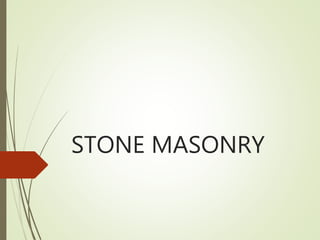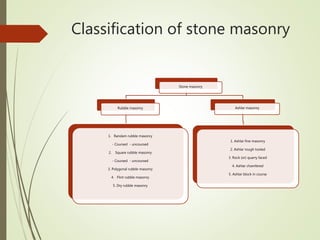Types of stone masonry
- 2. What is stone masonry? ïī Stone masonry is made of stone units bonded together with mortor.
- 3. Classification of stone masonry Stone masonry Rubble masonry 1. Randam rubble masonry - Coursed - uncoursed 2. Square rubble masonry - Coursed - uncoursed 3. Polygonal rubble masonry 4. Flint rubble masonry 5. Dry rubble masonry Ashlar masonry 1. Ashlar fine masonry 2. Ashlar rough tooled 3. Rock (or) quarry faced 4. Ashlar chamfered 5. Ashlar block in course
- 4. Random rubble masonry ïī Coursed
- 5. ContinueâĶ. ïī In this type of masonry, the stones used are of widely different sizes. This is the roughest and cheapest form of stone masonry. ïī In coursed random rubble masonry, the masonry work is carried out in courses such that the stones in a particular course are of equal height.
- 7. ContinueâĶ. ïī In this type of masonry, the stones used are of widely different sizes. This is the roughest and cheapest form of stone masonry. ïī In uncoursed random rubble masonry, the coarses are not maintained regularly. The larger stones are laid first and the spaces between them are then filled up by means of spalls or sneeks.
- 8. Square rubble masonry ïī Coursed
- 9. ContinueâĶ ïī In this type of masonry stones having straight bed and sides are used. The stones are usually squared and brought to hammer dressed or straight cut finish. ïī In the coursed square rubble masonry, the work is carried out in courses of varying depth.
- 10. ïī uncoursed
- 11. ContinueâĶ ïī In this type of masonry stones having straight bed and sides are used. The stones are usually squared and brought to hammer dressed or straight cut finish. ïī In the uncoursed square rubble masonry, the different sizes of stones having straight edges and sides are arranged on face in several irregular patterns.
- 13. ContinueâĶ ïī In this type of rubble masonry, the stones are hammer dressed. The stones used for face work are dressed in an irregular polygonal shape. Thus the face joints are seen running in an irregular fashion in all directions.
- 15. ContinueâĶ ïī In this type of masonry, stone used are flints or cobbles. These are irregularly shaped nodules of silica. The stones are extremely hard. But they are brittle and therefore they break easily.
- 17. ContinueâĶ ïī In this type of masonry, mortar is not used in the joints. This type of construction is the cheapest and requires more skill in construction. This may be used for non-load bearing walls such as compound walls, etcâĶ
- 18. ASHLAR MASONRY 1. ASHLAR FINE MASONRY
- 19. ContinueâĶ ïī In this type ashlar masonry, each stone is cut to uniform size and shape with all sides rectangular, so that the stone gives perfectly horizontal and vertical joints with adjoining stone. This type of ashlar masonry is very costly.
- 20. Ashlar rough tooled masonry
- 21. ContinueâĶ ïī In this type of ashlar masonry, the beds and sides are finely chisel-dressed. But the face is made rough by means of tools. A strip, about 25mm wide and made by means of chisel is provided around the perimeter of the rough dressed face of each stone.
- 22. Ashlar rock or quarry faced masonry
- 23. ContinueâĶ ïī In this type of ashlar masonry, a strip about 25mm wide and made by means of chisel is provided around the perimeter of every stone as in case of rough-tooled ashlar masonry. But the remaining portion of the face is left in the same form as received from quarry.
- 25. ContinueâĶ ïī In this type of ashlar masonry, the strip is provided as below. But it is chamfered or beveled at an angle of 45 degrees by means of chisel for a depth of about 25mm.
- 26. Ashlar back in course masonry
- 27. ContinueâĶ ïī This is combination of rubble masonry and ashlar masonry. In this type of masondry, the face work is provided with rough tooled or hammer dresses stones and backing of the wall may be made in rubble masonry.
- 28. Thank you



























